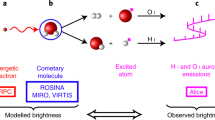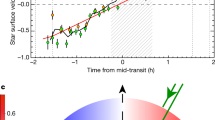Abstract
An extended source of H Lyα emission (1,216 Å) from the vicinity of Saturn has been detected previously by a rocket-borne spectrometer1, the OAO–Copernicus satellite2, and the Pioneer 11 spacecraft3. During the rocket experiment, in which Saturn was observed on 15 March 1975, 700 R±50% of Lyα emission was detected from the planet and an additional 200 R±50% from a 53 arc s diameter circular area centred on the planet. This additional emission was believed to emanate from the ring system. The Copernicus observations, carried out in April 1976 and April 1977, yielded Lyα intensities of 1.40±0.45 kR for the saturnian disk, <100 R for the rings, and 200±100 R for Titan's torus. During the Pioneer 11 Saturn flyby in August–September 1979, the long-wavelength channel UV photometer detected emissions from the planet, the vicinity of the rings, and the orbital path of Titan; these emissions were interpreted as resonant scattering of solar Lyα radiation by H atoms and possibly auroral Lyα emission from the planet. Several mechanisms for producing H atoms outside of Saturn's atmosphere have been proposed, including sputtering of water ice from the rings by magnetospheric charged particles4, ‘photo–sputtering’ of the ring water ice by solar UV radiation5, and escape of H atoms from Titan's atmosphere6. A more recent suggestion is the possible impact on the rings and subsequent neutralization of the protons from an extended saturnian ionosphere15. We report here a new investigation of these potential sources of Lyα emission in a series of observations of the saturnian system carried out between January and July 1980 using the short wavelength (SWP) spectrograph of the IUE Observatory7,8. North-south maps of the Lyα emission across the planet disk have shown pronounced spatial asymmetries in emission brightness. These asymmetries vary markedly on a time scale of days and are interpreted as bursts of Lyα emission of as much as 1 kR brightness averaged over a 6 × 10 arc s area, above a constant planetary emission level of 700–800 R. In fact, the Lyα emission peaks appear as essentially point source features in these data: if the emitting region is smaller than the 6 × 10 arc s instrumental resolution, the surface brightness must be proportionally higher.
This is a preview of subscription content, access via your institution
Access options
Subscribe to this journal
Receive 51 print issues and online access
$199.00 per year
only $3.90 per issue
Buy this article
- Purchase on Springer Link
- Instant access to full article PDF
Prices may be subject to local taxes which are calculated during checkout
Similar content being viewed by others
References
Weiser, H., Vitz, R. C. & Moos, H. W. Science 197, 755–757 (1977).
Barker, E. S., Cazes, S., Emerich, C., Vidal-Madjar, A. & Owen, T. Astrophys. J. 242, 383–394 (1980).
Judge, D. L., Wu, F.-M. & Carlson, R. W. Science 207, 431–434 (1980).
Cheng, A. F. & Lanzerotti, L. J. J. geophys. Res. 83, 2597–2602 (1978).
Carlson, R. W. Nature 283, 461 (1980).
McDonough, T. R. & Brice, N. M. Icarus 20, 136–145 (1973).
Boggess, A. et al. Nature 275, 377–385 (1978).
Lane, A. L. et al. Nature 275, 414–415 (1978).
Clarke, J. T., Moos, H. W., Atreya, S. K. & Lane, A. L. Astrophys. J. Lett. 241, 179–182 (1980).
Clarke, J. T. et al. Astrophys. J. 249, 696–701 (1980).
Mount, G. H., Rottman, G. J. & Timothy, J. G. J. geophys. Res. 85, 4271–4274 (1980).
Kliore, A. J. et al. Science 207, 446–449 (1980).
Bertaux, J. L., Festou, M., Barker, E. S. & Jenkins, E. B. Astrophys. J. 238, 1152–1159 (1980).
Desch, M. D. & Kaiser, M. L. (in preparation).
Luhmann, J. G. & Walker, R. J. J. geophys. Res. (in the press).
Author information
Authors and Affiliations
Rights and permissions
About this article
Cite this article
Clarke, J., Moos, H., Atreya, S. et al. IUE detection of bursts of H LYα emission from Saturn. Nature 290, 226–227 (1981). https://doi.org/10.1038/290226a0
Received:
Accepted:
Issue Date:
DOI: https://doi.org/10.1038/290226a0
This article is cited by
-
Morphological differences between Saturn's ultraviolet aurorae and those of Earth and Jupiter
Nature (2005)
-
Solar System Magnetospheres
Space Science Reviews (2005)
-
Intense Lyα emission from Uranus
Nature (1982)
-
Morphology of Saturn's aurora
Nature (1981)
Comments
By submitting a comment you agree to abide by our Terms and Community Guidelines. If you find something abusive or that does not comply with our terms or guidelines please flag it as inappropriate.



